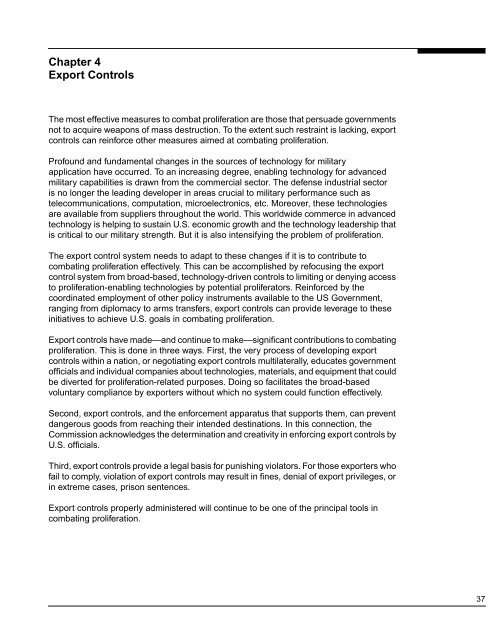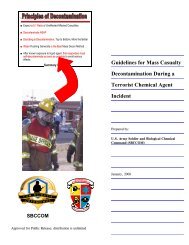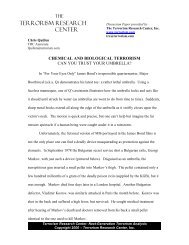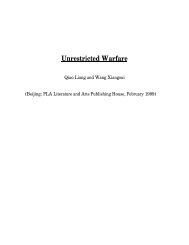- Page 1: CombatingProliferation ofWeapons of
- Page 7 and 8: ContentsExecutive Summary vIntroduc
- Page 9: Executive SummaryEvery American sho
- Page 12 and 13: Similarly, the Commission assessed
- Page 14 and 15: ole as a supplier of ballistic miss
- Page 16 and 17: economic, political, and diplomatic
- Page 18 and 19: Sixth, we must prepare for the thre
- Page 20 and 21: 82A (45p x 55p)
- Page 22 and 23: An improved mechanism for White Hou
- Page 24 and 25: esolved before the meetings occur.
- Page 26 and 27: In advising the President and ViceP
- Page 28: Recommendation 2.3: The President s
- Page 31 and 32: Chapter 3Managing the Interagency P
- Page 33 and 34: the CPC will need to set program re
- Page 35 and 36: Agency Budget ProcessesRecommendati
- Page 37 and 38: The Persian Gulf War gave vivid war
- Page 39 and 40: One example of poor coordination is
- Page 41 and 42: The lengthy time required for techn
- Page 43 and 44: • facilitating other countries’
- Page 45 and 46: efficiently among the departments,
- Page 47: organizations about proliferation t
- Page 51 and 52: inputting the data from 500,000 dec
- Page 53 and 54: e made accountable for ensuring tha
- Page 55 and 56: Chapter 5Findings and Recommendatio
- Page 57 and 58: for the government on a temporary b
- Page 59 and 60: Department of StateThe Department o
- Page 61 and 62: 5A (45p x 33p)49
- Page 63 and 64: • Civil aviation access to ports
- Page 65 and 66: Department of DefenseThe Department
- Page 67 and 68: The Commission is concerned that th
- Page 69: needs to be a top national priority
- Page 72 and 73: diplomacy and various forms of coop
- Page 74 and 75: Department of EnergyThe Department
- Page 76 and 77: All relevant DOE programs should be
- Page 78 and 79: Intelligence CommunityNational inte
- Page 80 and 81: incontrovertible evidence of these
- Page 82 and 83: Recommendation 5.15: The Director o
- Page 84 and 85: Department of CommerceThe Departmen
- Page 86 and 87: Recommendation 5.19: The Bureau of
- Page 88 and 89: Other AgenciesThe agencies discusse
- Page 90 and 91: could be used as carrots or sticks
- Page 92 and 93: Department of JusticeCombating prol
- Page 94 and 95: sides bring discrete skills and abi
- Page 96 and 97: Federal Bureau of InvestigationThe
- Page 98 and 99:
Personnel Requirements of the FBITh
- Page 100 and 101:
of intelligence and investigative i
- Page 102 and 103:
Of these areas, research and develo
- Page 104 and 105:
IssuesControl of biological materia
- Page 107 and 108:
Appendix A: Commission History and
- Page 109 and 110:
(f) Quorum.—A majority of the mem
- Page 111 and 112:
(c) Report.—(1) Not later than 18
- Page 113 and 114:
SEC. 717. PAYMENT OF COMMISSION EXP
- Page 115 and 116:
Appendix B: Commission Members and
- Page 117 and 118:
StaffSuzanne E. Spaulding, Executiv
- Page 119 and 120:
Appendix C: Individuals Interviewed
- Page 121 and 122:
Jimmy CarterFormer President of the
- Page 123 and 124:
William DesmondDirectorInitiatives
- Page 125 and 126:
Torrey FroscherChief of AnalysisDCI
- Page 127 and 128:
Laura HolgateDirectorOffice of Fiss
- Page 129 and 130:
LAnthony LakeFormer Assistant to th
- Page 131 and 132:
Maureen I. McCarthyScience Advisor
- Page 133 and 134:
PJohn ParachiniSenior AssociateMont
- Page 135 and 136:
Amy SandsAssociate DirectorCenter f
- Page 137 and 138:
Carmen SpencerDirector, Chemical an
- Page 139 and 140:
WJohn WadeColonel, USAActing Deputy
- Page 141 and 142:
Appendix D: Baseline Survey of Prol
- Page 143 and 144:
• Number of staff, not captured b
- Page 145 and 146:
Appendix E: Proliferation-related I
- Page 147 and 148:
Evaluates U.S. and Missile Technolo
- Page 149 and 150:
Counterproliferation Program Review
- Page 151 and 152:
Appendix F: Proliferation-related R
- Page 153 and 154:
Title (Legislation that Contains Re
- Page 155 and 156:
Title (Legislation that Contains Re
- Page 157:
Title (Legislation that Contains Re
- Page 160 and 161:
Illustrative 05x Sub-functionAs a s
- Page 162 and 163:
Department of Commerce• Bureau of
- Page 164 and 165:
Other Federal agencies or offices
- Page 166 and 167:
NPCNPTNSCNSGOFACO&MOMBOPCWOSTPPDDR&
- Page 168 and 169:
WMD Deterrence (Short of Military A
- Page 170 and 171:
Technology Programs (Sample):DoD Pr
- Page 172 and 173:
National Goal: WMD Deterrence (Shor
- Page 174 and 175:
• PE 603160BR: UAV-Based Collater
- Page 176 and 177:
FY 2002: Demonstrate a capability t
- Page 178 and 179:
R&D initiative in chemical and biol
- Page 180 and 181:
AbbreviationsACTDATDBWCALIOPECBCPRC
- Page 182 and 183:
qualifications I have suggested if
- Page 184 and 185:
Sunset ProvisionThe Task Force woul
- Page 186 and 187:
coordination authority to bring abo
- Page 188 and 189:
Presidential Decision Directive (PD
- Page 190 and 191:
• the confidence that others in t
- Page 192 and 193:
Missile Defense programs, and that
- Page 194 and 195:
development and implementation of n
- Page 196 and 197:
NSC Interagency Working Groups. PDD
- Page 198 and 199:
General, and such other members as
- Page 200 and 201:
Finally, the law required the Presi
- Page 202 and 203:
to enhance cooperation in the areas
- Page 204 and 205:
As has been true from the beginning
- Page 206 and 207:
meeting in March 1998, for example,
- Page 208 and 209:
two cross-cutting issue sets in the
- Page 210 and 211:
OSTP acts as the Executive Secretar
- Page 212 and 213:
A new Bureau of Nonproliferation (N
- Page 214 and 215:
The Coordinator of U.S. Assistance
- Page 216 and 217:
U.S. International Cooperative Effo
- Page 218 and 219:
Defense and Military ContactsThis p
- Page 220 and 221:
SupercontainersSupercontainers enha
- Page 222 and 223:
Government-to-Government Communicat
- Page 224 and 225:
Through this program, HHS will work
- Page 226 and 227:
U.S. - Russian—Canadian Project t
- Page 228 and 229:
Department of DefenseIntroductionOf
- Page 230 and 231:
functions of the Office of the Secr
- Page 232 and 233:
X11, 27x24Department of Defense’s
- Page 234 and 235:
• The United States Army Nuclear
- Page 236 and 237:
The annual report to Congress indic
- Page 238 and 239:
52sections. Requirements are then s
- Page 240 and 241:
and the Deputy Assistant to the Sec
- Page 242 and 243:
of the chemical and biological defe
- Page 244 and 245:
28 Interface between Individual Pro
- Page 246 and 247:
Department of EnergyHistorical Back
- Page 248 and 249:
The Office of Nonproliferation and
- Page 250 and 251:
The Nuclear Transfer and Supplier P
- Page 252 and 253:
diversion of weapons of mass destru
- Page 254 and 255:
• working with intelligence colle
- Page 256 and 257:
Had nuclear power expanded to the e
- Page 258 and 259:
• Proposed agreements for peacefu
- Page 260 and 261:
NPC: Current Authorities and Respon
- Page 262 and 263:
• Develop and implement plans for
- Page 264 and 265:
• greater use must be made of exp
- Page 266 and 267:
controlled items, the Commerce Cont
- Page 268 and 269:
the appropriateness of the items on
- Page 270 and 271:
Export Enforcement is comprised of
- Page 272 and 273:
Because OEE has a larger national f
- Page 274 and 275:
Department of the TreasuryUnited St
- Page 276 and 277:
narcotics. When AES matches shipmen
- Page 278 and 279:
The Counterproliferation program al







